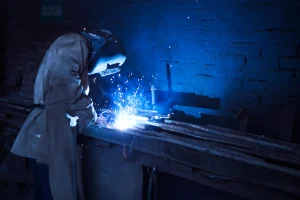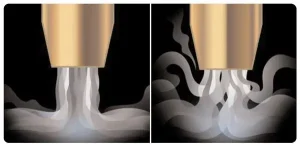In the realm of welding, TIG welding stands tall as a precision technique, renowned for its finesse and versatility. TIG welding, short for Tungsten Inert Gas welding, employs a non-consumable tungsten electrode to create the weld. This method is particularly prized for its ability to produce clean, high-quality welds across various materials, from stainless steel to aluminum. However, CO2, or carbon dioxide, traditionally finds its place in welding as a shielding gas for processes like MIG welding. Its role in TIG welding, though, is often questioned. So, can you use CO2 for TIG welding? Let’s delve into this inquiry further.
Understanding TIG Welding
TIG welding, also known as Gas Tungsten Arc Welding (GTAW), is a precise welding process celebrated for its versatility and quality. TIG welding utilizes a non-consumable tungsten electrode to create the arc, which melts the base metal and filler material (if used) to form the weld pool. The process is shielded by an inert gas, typically argon, to prevent atmospheric contamination and ensure a clean weld.
The components of a TIG welding setup include the welding machine, power source, tungsten electrode, shielding gas supply, torch, and filler rod. Each component plays a crucial role in controlling the welding arc, shielding the weld, and delivering filler material if needed.
One of the primary advantages of TIG welding is its ability to produce high-quality welds across a wide range of materials, including stainless steel, aluminum, and exotic alloys. The process offers precise control over the heat input, resulting in minimal distortion and excellent bead appearance. Additionally, TIG welding allows for welding thin materials without burning through, making it ideal for intricate projects and precision work.
CO2 Gas in Welding
Understanding the significance of shielding gases in welding is paramount. These gases serve the crucial role of protecting the weld area from atmospheric contamination, ensuring a clean and strong bond between metals. Among the array of shielding gases available, CO2 emerges as a prominent choice, particularly in certain welding processes.
CO2, or carbon dioxide, functions as a shielding gas by displacing oxygen and other atmospheric elements that can negatively impact the weld. Its effectiveness in this role makes it a preferred option for various welding applications, including MIG (Metal Inert Gas) welding and some forms of flux-cored arc welding.
The applications of CO2 in welding are diverse. From automotive manufacturing to structural fabrication, CO2 finds its utility in welding carbon steel and low-alloy steel components. Its affordability and accessibility make it a favored choice in industries where cost-effectiveness is a priority. However, while CO2 boasts several advantages, its use in certain welding processes like TIG welding prompts questions and considerations. Can you use CO2 for TIG welding? Let’s delve deeper into this inquiry.
CO2 in TIG Welding: Pros and Cons
Exploring the advantages of using CO2 in TIG welding reveals compelling reasons for its consideration. Firstly, its cost-effectiveness makes it an attractive option, especially for budget-conscious welders. Additionally, CO2 can contribute to increased welding speed, boosting productivity without compromising quality. Moreover, CO2 is particularly suitable for certain materials, such as carbon steel, where its chemical properties facilitate efficient welding.
However, it’s crucial to acknowledge the disadvantages of using CO2 in TIG welding. One significant concern is the potential for porosity in the weld, which can compromise its integrity and strength. Furthermore, CO2’s limited applicability to certain metals, like aluminum and stainless steel, restricts its versatility in TIG welding applications. Additionally, the impact on weld quality is a critical consideration, as CO2 may result in inferior weld characteristics compared to other shielding gases.
Considering these pros and cons is essential when evaluating the feasibility of using CO2 for TIG welding. While it offers cost advantages and increased speed, its limitations and potential drawbacks necessitate careful consideration in specific welding scenarios. So, can you use CO2 for TIG welding effectively? Let’s delve deeper into this question.
Best Practices for Using CO2 in TIG Welding
When considering CO2 for TIG welding, adhering to best practices is paramount for achieving optimal results.
Ensuring proper setup and equipment is the foundation of successful welding with CO2. This includes selecting the appropriate welding machine and gas supply system, as well as calibrating settings for optimal performance.
Employing effective welding techniques can enhance the quality and efficiency of CO2 TIG welding. This may involve maintaining proper arc length, controlling travel speed, and utilizing appropriate filler materials to achieve desired weld characteristics.
Moreover, prioritizing safety precautions is essential when working with CO2 in TIG welding. This includes proper ventilation to mitigate exposure to fumes, wearing appropriate personal protective equipment (PPE), and following established safety protocols to prevent accidents and injuries.
By adhering to these best practices, welders can harness the benefits of CO2 for TIG welding while minimizing risks and ensuring the integrity of the weld. So, can you use CO2 for TIG welding effectively? Let’s delve deeper into the nuances of employing CO2 in this welding process.
Alternatives to CO2 in TIG Welding
Exploring alternatives to CO2 in TIG welding opens up a realm of possibilities for welders seeking optimal results.
Comparing with other shielding gases reveals varying characteristics and applications. For instance, argon, a popular alternative, offers superior arc stability and weld quality compared to CO2. On the other hand, helium provides higher heat input, enabling faster welding speeds but at a higher cost.
Understanding the pros and cons of alternative gases is crucial in making informed decisions. While argon boasts excellent weld quality and versatility, it comes with a higher price tag. Helium, despite its faster welding speeds, may present challenges in arc stability and weld penetration.
Several factors come into play when choosing a shielding gas for TIG welding. These include the type of material being welded, desired weld characteristics, budget constraints, and availability of gases. By carefully evaluating these factors, welders can select the most suitable shielding gas for their specific application, ensuring optimal results and efficiency.
Considering these alternatives and factors can broaden the horizons of TIG welding practices, offering welders greater flexibility and control in achieving desired outcomes. So, can you use CO2 for TIG welding, or are there better alternatives? Let’s explore further.
Conclusion
In conclusion, while CO2 for TIG welding presents both advantages and limitations, it’s essential to weigh its suitability for specific applications carefully. The decision hinges on factors like material type, desired weld quality, and budget constraints. Can you use CO2 for TIG welding effectively? It depends on the context.







![How TIG Welding works? [Understanding of TIG Welding] How TIG Welding works](https://protigwelder.com/wp-content/uploads/2021/12/How-TIG-Welding-works-1-150x150.jpg)

![Difference Between TIG and MIG Welding? | [Update 2022] Difference Between TIG and MIG Welding](https://protigwelder.com/wp-content/uploads/2021/12/Difference-Between-TIG-and-MIG-Welding-1-150x150.jpg)

![What is MIG and TIG Welding | Best Guide 2022 [PTW] what is mig and tig welding (1)](https://protigwelder.com/wp-content/uploads/2022/01/what-is-mig-and-tig-welding-1-150x150.jpg)
![What Is Friction Welding Process? | [Best Guide - PROTIGWELDER] What Is Friction Welding Process](https://protigwelder.com/wp-content/uploads/2022/01/What-Is-Friction-Welding-Process-150x150.jpg)
![What Is Shielded Metal Arc Welding (SMAW) | [Complete Guide] What Is Shielded Metal Arc Welding (SMAW)](https://protigwelder.com/wp-content/uploads/2022/01/What-Is-Shielded-Metal-Arc-Welding-SMAW-150x150.jpg)